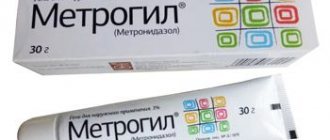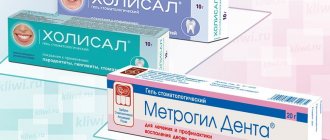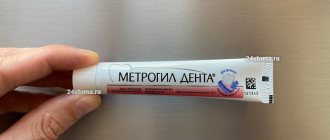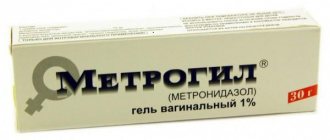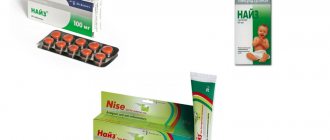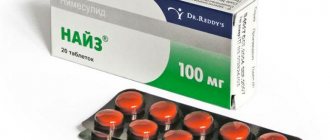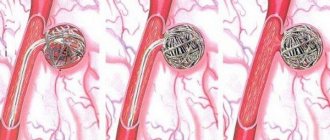Gum inflammation is accompanied by a number of painful symptoms that not only affect your well-being, but also affect your ability to chew and speak normally. To eliminate unpleasant signs in dentistry, special gels are used. They act directly on the oral mucosa and are slightly absorbed into the blood, which makes them safe for children.
Painkillers and anti-inflammatory gels can be used during teething (Baby Doctor) and for complex treatment of gingivitis or stomatitis.
Indications for use of dental gels
The dentist may prescribe the gel to a child or adult when there are signs of gum inflammation. The reason for using the gel will also be stomatitis, which affects not only the gums, but also the entire oral mucosa.
Dental gel will help with the following symptoms and diseases:
- pain, burning, redness along the edge of the tooth crown;
- bleeding gums after chewing hard foods and brushing teeth;
- thrush, fungal stomatitis or oral candidiasis;
- glossitis (inflammation of the tongue) and papillitis (inflammation of the dental papilla);
- teething in a child;
- growth of wisdom teeth, which is accompanied by gum damage.
The medicine can only be used topically. The gel is applied to the affected areas of the mucous membrane up to 4 times a day, according to the instructions. After treating the gums, it is recommended not to eat anything for several hours, and not to drink for at least half an hour, so as not to wash off the drug. Before applying, be sure to rinse your mouth with an antiseptic or regular mouthwash.
Some types of gels are homeopathic remedies, therefore, in case of severe inflammation and pain they will be ineffective (Malavit), others have a strong anti-inflammatory and analgesic effect. There is a large selection of dental gels; it is important to understand how they differ, and which one is better for a particular problem.
Diagnosis of gum inflammation
Conversation with the patient. An initial appointment with a dentist begins with collecting an anamnesis - that is, information about the patient’s health condition. During the conversation, the doctor will pay attention to the following aspects:
- Professional activity. In order to make a correct diagnosis, the doctor will need to know the patient’s profession. For example, if a person works in a hazardous industry, we can conclude that dangerous working conditions could provoke gum inflammation.
- General health. During the conversation, the doctor will also ask about chronic or recent acute diseases and the progress of their treatment. This is necessary to exclude or confirm a connection between gum inflammation and pathologies of other organs and systems.
- Quality of oral hygiene. The doctor will ask the patient about the toothbrushes and toothpastes used, regular oral hygiene, and the presence of bad habits (primarily smoking). This will allow you to evaluate possible factors that provoke gum inflammation.
- Current symptoms. The dentist will definitely ask you to list all the complaints that concern the patient. Based on the symptoms that appear, the doctor will conclude that there is one or more concomitant oral diseases.
Examination of the oral cavity. During the examination, the doctor will assess the condition of the teeth, gums, tongue and mucous membrane, pay attention to the correctness of the bite and the condition of dentures (if any). If the dentist finds that the oral mucosa is swollen and red, and there is microbial plaque or tartar on the teeth, this will help confirm the diagnosis. To assess the mobility of teeth and the condition of the gums, the dentist may try to “wiggle” the teeth with special tweezers. Examination of the oral cavity is usually completely painless.
Up to contents
Which gel is better?
A well-known representative is Dental. This is an anti-inflammatory gel; it contains corn oil, which promotes the formation of a protective barrier on the mucous membrane, which allows damaged cells to recover faster and prevent complications.
It is recommended to use Dental up to 4 times a day, applying it in a thin layer to the entire surface of the inflamed gum. This drug will also help those who are faced with denture stomatitis. The drug accelerates regeneration, reduces inflammation and relieves pain.
Parodium is another good remedy for inflammatory diseases of the oral mucosa. It is both an antiseptic and has an anti-inflammatory and hemostatic effect. Indicated for the treatment of periodontitis, gingivitis, traumatic and bacterial stomatitis.
Kalgel and Baby Doctor are one of the safest products for children during teething. They relieve pain, cool the gums, and begin to act almost instantly. Their only drawback is the short duration of pain relief; they can relieve unpleasant symptoms for up to 30 minutes.
The most well-known representatives, which are most often recommended by dentists, are the gels Metrogyl Denta, Asepta, Cholisal, Solcoseryl and Kamistad.
Instructions for use
In the later stages of pregnancy, the dentist prescribes it when infectious and inflammatory pathologies of the mouth are detected. A woman should not ignore medical recommendations. Any untreated infection will cause symptoms of general intoxication of the body. Such an action will negatively affect the intrauterine growth and development of the fetus and harm the health of the mother.
The duration of therapy recommended during pregnancy in the instructions for use of Metrogyl Denta is 5-14 days. When carrying a child, the drug is prescribed for the shortest possible time and in low doses . This helps minimize the likelihood of side effects. Breastfeeding should be discontinued during treatment with dental gel.
Indications and contraindications
A contraindication to the use of Metrogyl Denta during pregnancy is intolerance to the active or auxiliary ingredients. Also, it cannot be used to prevent gingivitis and other dental pathologies. The gel is prescribed to patients when diagnosing the following periodontal diseases:
- Vincent's ulcerative necrotic gingivitis;
- post-extraction alveolitis;
- acute or chronic periodontitis.
The drug is used to treat cheilitis - inflammation that affects the red border, mucous membrane and skin of the lips. It quickly destroys infectious agents of stomatitis, especially its aphthous form.
Scheme of use during pregnancy
From the second trimester of pregnancy, a thin layer of Metrogyl Dent should be applied to the gums in the morning and evening. The procedure should be carried out only with clean hands using a cotton pad or swab.
After application, you should refrain from eating food and water for 30-40 minutes.
If periodontitis is detected during pregnancy, then Metrogyl Denta gel is used after cleaning the tartar. The dentist will show the woman how to treat a periodontal pocket. In the future, she carries out the procedure independently at home. The average duration of use is 7-10 days.
Side effects
In the second and third trimesters of pregnancy, the use of Metrogyl Denta may cause the development of allergies. Clinically, it manifests itself in the form of small rashes, itching, swelling and redness of the skin.
Metrogil Denta
Contains an antibacterial substance - metronidazole and an antiseptic - chlorhexidine. It is used to relieve gum pain during stomatitis, after dental treatment, during an inflammatory process due to infection or traumatic injury.
The gel is practically not absorbed, therefore it is safe for treating the oral mucosa of a child. But at the same time, the low concentration of the active ingredient makes it not the most effective against severe inflammation; after treatment, there may be a relapse.
Metrogyl denta dental gel for gums 20g
Registration number
P N015982/01
Trade name
Metrogyl Denta®
International nonproprietary or generic name
Metronidazole + Chlorhexidine
Dosage form
dental gel
Compound
1 gram of gel contains:
active ingredients: metronidazole benzoate 16.0 mg (equivalent to metronidazole 10.0 mg), chlorhexidine digluconate 20% solution 2.5 mg (equivalent to chlorhexidine digluconate 0.5 mg).
excipients: propylene glycol 50.0 mg, carbomer-980 15.0 mg, disodium edetate 0.5 mg, saccharin 1.0 mg, levomenthol 5.0 mg, sodium hydroxide 4.0 mg, water up to 1 g.
Description
white or off-white opalescent soft gel
Pharmacotherapeutic group
Antimicrobial agent
ATX code A01AB11
Pharmacological properties
The effectiveness of the drug is due to the presence of two antibacterial components in its composition:
a) metronidazole has an antibacterial effect against anaerobic bacteria that cause periodontal diseases: Porphyromonas gingivalis, Prevotella intermedia, Fusobacterium fusiformis, Wolinella recta, Eikenella corrodens, Borrelia vincenti, Bacteroides melaninogenicus, Selenomonas spp.
b) chlorhexidine is an antiseptic and antimicrobial agent, effective against gram-positive and gram-negative aerobic and anaerobic bacteria (Treponema spp., Neisseria gonorrhoeae, Trichomonas spp., Chlamydia spp., Ureaplasma spp., Bacteroides fragilis). Some strains of Pseudomonas spp., Proteus spp. are weakly sensitive to the drug, and acid-resistant forms of bacteria and bacterial spores are also resistant. Does not interfere with the functional activity of lactobacilli. When applied topically, Metrogyl Denta gel is practically not absorbed.
Indications for use
Infectious and inflammatory diseases of periodontal and oral mucosa:
- acute and chronic gingivitis;
- acute ulcerative-necrotizing gingivitis of Vincent;
- acute and chronic periodontitis;
- juvenile periodontitis;
- periodontal disease complicated by gingivitis;
- aphthous stomatitis;
- cheilitis;
- inflammation of the oral mucosa when wearing dentures;
- post-extraction alveolitis (inflammation of the socket after tooth extraction);
- periodontitis, periodontal abscess (as part of combination therapy).
Contraindications
- hypersensitivity to metronidazole, chlorhexidine, nitroimidazole derivatives or other components of the drug;
- diseases of the blood system, including a history;
- diseases of the peripheral and central nervous system;
- children under 18 years of age.
Use during pregnancy and breastfeeding
Due to the lack of clinical data, the safety of the drug during pregnancy and breastfeeding has not been established. The use of the drug during pregnancy is not recommended. During the period of breastfeeding, if it is necessary to prescribe the drug, the issue of stopping breastfeeding should be decided.
Directions for use and doses
Topically, for dental use only.
For inflammation of the gums (gingivitis):
Metrogyl Denta® is applied to the gum area with a thin layer with your finger or with a cotton swab 2 times a day.
After applying the gel, you should refrain from drinking and eating for 30 minutes.
It is not recommended to wash off the gel. The duration of treatment is on average 7-10 days.
For periodontitis:
After removing dental plaque, periodontal pockets are treated with Metrogyl Denta® gel, and the gel is applied to the gum area.
Exposure time – 30 min. The number of procedures depends on the severity of the disease.
In the future, the patient can apply the gel independently. Metrogyl Denta® is applied to the gum area 2 times a day for 7-10 days.
For aphthous stomatitis:
Metrogyl Denta® is applied to the affected area of the oral mucosa 2 times a day for 7-10 days.
To prevent exacerbations of chronic gingivitis and periodontitis:
Metrogyl Denta® gel is applied to the gum area 2 times a day for 7-10 days.
Preventive courses of treatment are carried out 2-3 times a year.
To prevent post-extraction alveolitis:
after tooth extraction, the hole is treated with Metrogyl Denta® gel, then the gel is applied 2-3 times a day for 7-10 days.
Side effect
When using the drug Metrogyl Denta® topically, dental gel, allergic reactions (skin rash, itching, urticaria, anaphylactic reactions, including anaphylactic shock), as well as headache, may occur.
Overdose
Accidental or intentional ingestion of a large amount of gel may cause increased side effects, mainly caused by metronidazole (chlorhexidine is practically not absorbed from the gastrointestinal tract).
The following may be observed: nausea, vomiting, dizziness, and in more severe cases – paresthesia and convulsions.
Treatment:
gastric lavage, symptomatic therapy if necessary.
Interaction with other drugs
When applied topically in recommended doses, no systemic interaction of MetrogilDent® gel with other drugs was detected.
special instructions
The use of Metrogyl Denta® does not replace hygienic brushing of teeth, therefore, during the course of treatment with the drug, teeth brushing should be continued.
The drug should be stored out of the reach of children.
If the drug is accidentally or intentionally swallowed by a child, seek immediate medical attention.
If the medicine has become unusable or has expired, do not throw it into wastewater or onto the street!
Place the medication in a bag and place it in the trash. These measures will help protect the environment!
Impact on the ability to drive vehicles and other mechanisms
There is no information on the effect of the drug on the ability to drive vehicles and engage in other potentially hazardous activities that require increased concentration and speed of psychomotor reactions.
Release form
Dental gel.
5 g, 10 g or 20 g in a plastic laminated tube, the neck of which is sealed with aluminum foil, laminated with polyethylene and with a screw cap made of polypropylene.
One tube in a cardboard box with instructions for use.
5 g, 10 g or 20 g in a plastic laminated tube, the neck of which is sealed with aluminum foil laminated with polyethylene and with a polypropylene screw cap with a protrusion for perforating the foil.
One tube in a cardboard box with instructions for use.
Storage conditions
At a temperature not higher than 25 C.
Keep out of the reach of children.
Best before date
3 years.
Do not use after expiration date.
Vacation conditions
Over the counter.
Solcoseryl
One of the most popular gels in dentistry is Solcoseryl. This remedy is classified as a medicine (while many others act as balms), therefore it is recommended by dentists for the treatment of such unpleasant pathologies as oral candidiasis, viral, traumatic and necrotizing ulcerative stomatitis.
Solcoseryl gel will help get rid of pain; the active ingredients in its composition stimulate metabolic processes in the affected tissues, which accelerates regeneration.
Metrogyl Gel – guards against skin and genital tract infections
In this release form, metronidazole is evenly distributed in a gel-like substance. In addition to the main component, the medicine contains preservatives, a special gelling agent carbomer 940, a thickener propylene glycol, complex salts to improve the adhesion of the components and water. The color of the gel is from transparent to light yellow.
Metrogil Gel is produced for cutaneous and vaginal use.
The gel for external use is packaged in metal tubes weighing 30 grams and contains 10 mg of active ingredient per 1 gram of product.
Vaginal gel is available in tubes with the same weight and concentration of metronidazole, but it comes with a special applicator that allows you to easily administer the medicine.
